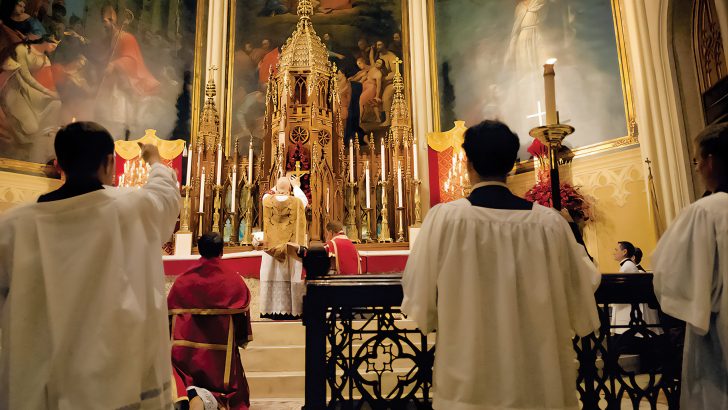Life and Liturgy
by Louis Bouyer (Sheed &Ward, revised edition, London 1978)
When we gather to celebrate the Mass and receive the Eucharist, we are constituted as the people of God. We were not so beforehand, except in potential. This is what Pope Pius XI meant when he described the Mass as “the principal organ of the Church” – without it, we could not be considered the Church.
That, at least, is the view of liturgist Fr Louis Bouyer in his book Life and Liturgy. Fr Bouyer converted to Catholicism from High Lutheranism, attracted largely by the Church’s liturgical traditions. He was a significant figure in proposing change during Vatican II, acting as an advisor on liturgy. Life and Liturgy was originally written pre-Vatican II, but Fr Bouyer revised it significantly and the re-released edition reflects many of the findings of the council.(Confusingly, the book, based on lectures given in Notre Dame University, was first published in the USA in 1954 as Liturgical Piety. Select the later British Sheed and Ward editions from 1978 or 1989 for preference.)
Coming from outside the Faith, as it were, Fr Bouyer had no qualms drawing from traditions outside the Church. For example, one of the chapters in Life and Liturgy devotes much time to what he considers the excellent efforts of Anglicans to preserve elements from the liturgy, efforts which were often more successful than the Church’s.
Effort
The book itself is an effort to examine the liturgy using what the historical sciences had revealed about the Mass and the development of its forms. In doing so, he is able to strike a neat balance between criticism of the ‘fossilised’ liturgical celebrations of the time, which had developed little since the 16th Century, with a call for renewal, not for its own sake, but to return the liturgy to its roots.
He begins with an examination of the 1950s liturgy and attitudes towards it. What he discerns is a mindset which saw the Mass as being an external sign of the Church, rather than its lifeblood. People prayed at Mass, they didn’t pray the Mass, and while there was a sentimental attachment to the Real Presence and Christ’s sacrifice, it lacked the ‘sober mysticism’ of the early Church.
Developments in the historical sciences enabled Fr Bouyer to explore the history of the liturgy, returning to the qahal, the Jewish convocation and precursor to the Catholic Mass. He draws from this the key aspects of liturgical celebration properly defined, and its shape or structures. From there, he explains in detail the teachings of the Church Fathers, before again putting in context the modern development of the liturgy.
Studies
And where do Fr Bouyer’s studies lead him? To the conclusion that the life of the Church always comes back to the Cross, not as a sign of suffering, but of Resurrection. The Mass is where we offer to God the perfect offering of Christ’s sacrifice, receiving it, returning it and in so doing becoming children of God.
The book concludes with a final call to integrate the liturgy into our lives fully, so that we recognise the Mass as constitutive of our Faith, as opposed to its external sign: “[T]he world of the sacraments, the world into which the liturgy introduces us is not a world in its own right…it is rather the meeting-point of the world of the Resurrection with this very world of ours in which we must live, suffer and die.”
Without a proper liturgical life, the Church becomes either over-sentimental or over-intellectual. The benefit for us, as readers, is that Fr Bouyer is neither of these things. In addition, he is determined to be understood by the layman. It takes hard-work all the same, but his fluid prose and playfulness make for lively reading – by the standards of the theology.


 Ruadhán Jones
Ruadhán Jones Fr Stanley Klores
celebrates the traditional Latin Mass in St Patrick’s Church in New Orleans.
Fr Stanley Klores
celebrates the traditional Latin Mass in St Patrick’s Church in New Orleans. 